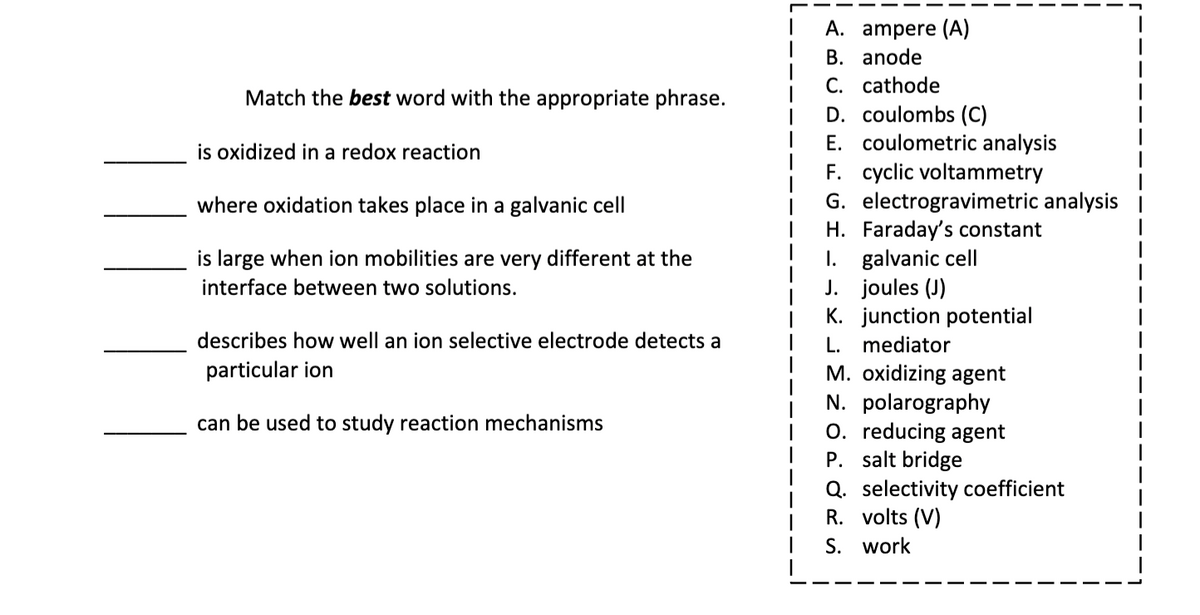A. ampere (A) B. anode C. cathode D. coulombs (C) E. coulometric analysis F. cyclic voltammetry G. electrogravimetric analysis H. Faraday's constant galvanic cell J. joules (J) K. junction potential L. mediator Match the best word with the appropriate phrase. is oxidized in a redox reaction where oxidation takes place in a galvanic cell is large when ion mobilities are very different at the I. interface between two solutions. describes how well an ion selective electrode detects a particular ion M. oxidizing agent N. polarography O. reducing agent P. salt bridge can be used to study reaction mechanisms Q. selectivity coefficient R. volts (V) S. work
A. ampere (A) B. anode C. cathode D. coulombs (C) E. coulometric analysis F. cyclic voltammetry G. electrogravimetric analysis H. Faraday's constant galvanic cell J. joules (J) K. junction potential L. mediator Match the best word with the appropriate phrase. is oxidized in a redox reaction where oxidation takes place in a galvanic cell is large when ion mobilities are very different at the I. interface between two solutions. describes how well an ion selective electrode detects a particular ion M. oxidizing agent N. polarography O. reducing agent P. salt bridge can be used to study reaction mechanisms Q. selectivity coefficient R. volts (V) S. work
Principles of Modern Chemistry
8th Edition
ISBN:9781305079113
Author:David W. Oxtoby, H. Pat Gillis, Laurie J. Butler
Publisher:David W. Oxtoby, H. Pat Gillis, Laurie J. Butler
Chapter17: Electrochemistry
Section: Chapter Questions
Problem 99AP
Related questions
Question
Please answer all.

Transcribed Image Text:A. ampere (A)
B. anode
C. cathode
D. coulombs (C)
E. coulometric analysis
F. cyclic voltammetry
G. electrogravimetric analysis
H. Faraday's constant
I. galvanic cell
J. joules (J)
K. junction potential
L. mediator
Match the best word with the appropriate phrase.
is oxidized in a redox reaction
where oxidation takes place in a galvanic cell
is large when ion mobilities are very different at the
interface between two solutions.
describes how well an ion selective electrode detects a
particular ion
M. oxidizing agent
N. polarography
O. reducing agent
P. salt bridge
can be used to study reaction mechanisms
Q. selectivity coefficient
R. volts (V)
S. work
Expert Solution
This question has been solved!
Explore an expertly crafted, step-by-step solution for a thorough understanding of key concepts.
Step by step
Solved in 2 steps

Knowledge Booster
Learn more about
Need a deep-dive on the concept behind this application? Look no further. Learn more about this topic, chemistry and related others by exploring similar questions and additional content below.Recommended textbooks for you

Principles of Modern Chemistry
Chemistry
ISBN:
9781305079113
Author:
David W. Oxtoby, H. Pat Gillis, Laurie J. Butler
Publisher:
Cengage Learning

Chemistry by OpenStax (2015-05-04)
Chemistry
ISBN:
9781938168390
Author:
Klaus Theopold, Richard H Langley, Paul Flowers, William R. Robinson, Mark Blaser
Publisher:
OpenStax

General Chemistry - Standalone book (MindTap Cour…
Chemistry
ISBN:
9781305580343
Author:
Steven D. Gammon, Ebbing, Darrell Ebbing, Steven D., Darrell; Gammon, Darrell Ebbing; Steven D. Gammon, Darrell D.; Gammon, Ebbing; Steven D. Gammon; Darrell
Publisher:
Cengage Learning

Principles of Modern Chemistry
Chemistry
ISBN:
9781305079113
Author:
David W. Oxtoby, H. Pat Gillis, Laurie J. Butler
Publisher:
Cengage Learning

Chemistry by OpenStax (2015-05-04)
Chemistry
ISBN:
9781938168390
Author:
Klaus Theopold, Richard H Langley, Paul Flowers, William R. Robinson, Mark Blaser
Publisher:
OpenStax

General Chemistry - Standalone book (MindTap Cour…
Chemistry
ISBN:
9781305580343
Author:
Steven D. Gammon, Ebbing, Darrell Ebbing, Steven D., Darrell; Gammon, Darrell Ebbing; Steven D. Gammon, Darrell D.; Gammon, Ebbing; Steven D. Gammon; Darrell
Publisher:
Cengage Learning

Chemistry: Principles and Practice
Chemistry
ISBN:
9780534420123
Author:
Daniel L. Reger, Scott R. Goode, David W. Ball, Edward Mercer
Publisher:
Cengage Learning


Chemical Principles in the Laboratory
Chemistry
ISBN:
9781305264434
Author:
Emil Slowinski, Wayne C. Wolsey, Robert Rossi
Publisher:
Brooks Cole